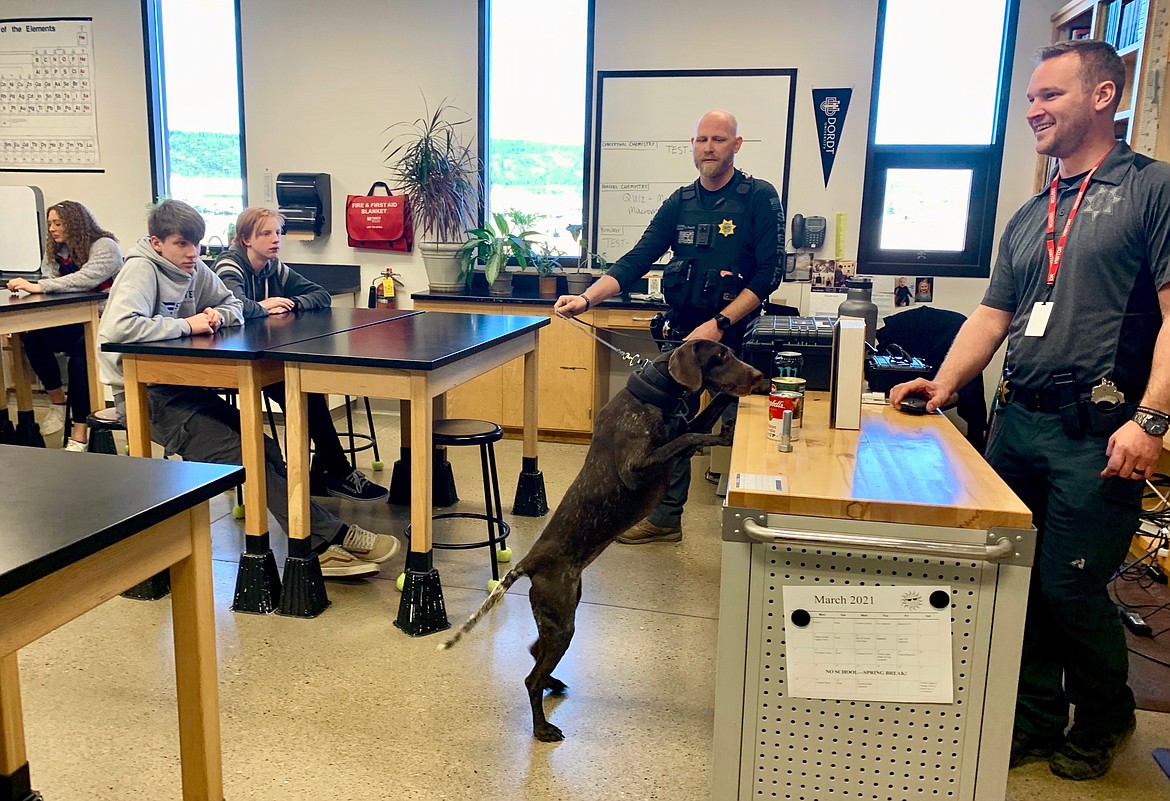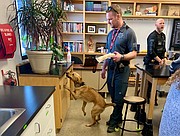Extraordinary sniffers: Sheriff's Office K-9 unit demonstrates smelling ability at Stillwater School
HILARY MATHESON | Hagadone News Network | UPDATED 4 years, 9 months AGO
Flathead County Sheriff’s Office Deputies Charles Pesola and Matt Vander Ark visited Stillwater Christian School recently to demonstrate dogs' amazing sense of smell.
“We have about 5 million olfactory bulbs in our brain and nose system. I'm not a doctor or a scientist, so we’re going to use easy words,” Pesola said. “A dog has between 300 to 500 million of those. And different breeds have different amounts.”
He was referring to not just any dogs, but Victor, a Labrador retriever, and Misty, a German shorthaired pointer — members of the sheriff’s office K-9 unit.
“We can smell and discriminate against basic and large odors. Dogs can do that on a very small micro level and they’re able to separate those odors,” he said, for example, at lunch, a student might primarily smell hamburgers while the canines are able to smell everything on the plate and distinguish one odor from the next.
Victor and Misty are working dogs used to detect narcotics by smelling specific odors they’ve been trained to search for.
“Dogs like this are designed to smell and to search for things. There’s a drive built into them,” Pesola said about why there is a movement in law enforcement to seek out sporting breeds for detection work in addition to their approachability when interacting with the public such as visiting schools.
WHILE VANDER ARK talked about the health effects and dangers of drugs prevalent in the Flathead Valley such as methamphetamine, heroin, fentanyl and cocaine, Pesola stood nearby holding Misty’s leash as she eagerly sniffed and paced around — curious and antsy to search her new surroundings and take in every scent.
Vander Ark then showed one way the K9 unit has made the task of searching more efficient. Opening a case, Vander Ark took out some everyday objects — a soda can, soup can and book — and showed how criminals use them to contain and conceal illegal drugs.
“It makes our job a whole lot harder, but with the canines, we can actually find the cans that have the drugs in them,” Vander Ark said.
Pesola said the sheriff’s office recently assisted another agency in searching a home that had books from floor to ceiling.
“Misty and I went searching and … she alerted me, ‘hey, I sniff something,’ ” Pesola said.
Once Misty directed him to the area of the odor he began searching the books and found a significant amount of fentanyl, heroin and methamphetamine.
If a search doesn’t result in drugs being found, the deputies said it could be the suspects hid them very well, or the drugs were no longer there, but the odor still lingers, using the smell of burnt popcorn as an example.
The dogs spent at least 10 hours in training before they started working. The deputies said the dogs go through blind and double-blind training so their focus is on the task at hand, not the actions of a handler. Pesola said he comes secondary to the dog’s job.
“She doesn’t depend on me. She doesn’t even care what I do while she’s searching. I’m going to prove that,” he said, leading her around the classroom. “I’ll keep talking to you guys and she’ll be searching.”
This is important so that a dog ignores body language, whether conscious or unconscious, so that it can’t be construed a dog was given cues.
AS MISTY circled around the classroom she made a few stops along the way, panting and scratching at cabinet doors, her tail wagging, otherwise ignoring Pesola, the students and even tennis balls attached to the legs of stools students were sitting on.
As she picked up scents, Pesola said students would notice her tail wagging faster or slower, which are known as alerts. Dogs are also supposed to give what is known as an “indicator,” which is important in court.
“You saw with Victor he has a very still stare into the odor,” he said. “He’ll stop and just stare into the odor and he’ll wait for his toy. His head will kind of flop back and forth, but that’s him anticipating the toy, an alert behavior, but the indication behavior is the stopping and the search and the staring at the odor.
“Misty has the same indication, but you’ll see a lot more alert type behavior, ” Pesola said.
WHILE THE dogs live with their handlers, they are not treated like family pets. As working dogs, Pesola and Vander Ark said they don’t want the dogs to find staying home more rewarding than being on the job.
The K-9 program started in June 2019 and was created by Sheriff Brian Heino and funded primarily through donations. The K-9 program costs about $25,000 per dog, which covers buying the dog, training, equipment and veterinary bills, according to Vander Ark.
Within a year, the deputies said the program is expected to bring in two more canines, for a total of four. Vander Ark added that work continues to establish the Flathead K-9 Foundation as an avenue for people who wish to donate to help defray costs, namely for people in the community who volunteer to pay to train and certify dogs to work in areas such as search and rescue or detecting explosives.
Reporter Hilary Matheson may be reached at 758-4431 or by email at [email protected].
ARTICLES BY HILARY MATHESON
Whitefish High School wins East Helena speech and debate tournament
Scoring 225 points, the Whitefish High School speech and debate team took first place at a weekend tournament.

Glacier High speech and debate team secures second in Bozeman
The Glacier High School speech and debate team secured second place, and Flathead High School, third in Bozeman.

Heritage Academy expands, moves to new location in Kalispell
Heritage Academy, a hybrid private and homeschool program referred to as a microschool, has moved to a new location, Easthaven Baptist Church, 2010 Whitefish Stage Road in Kalispell.



